12+ SAMPLE Request For Information
-
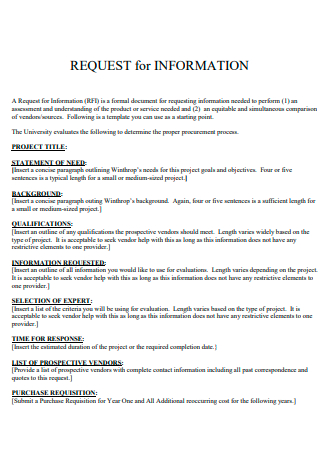
Request For Information Template
download now -
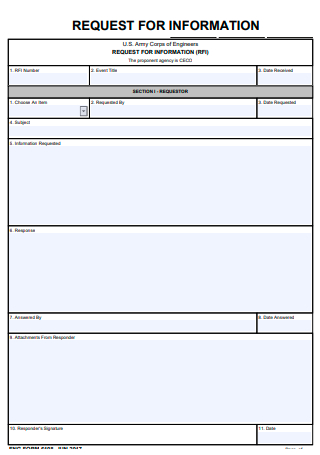
Basic Request For Information
download now -
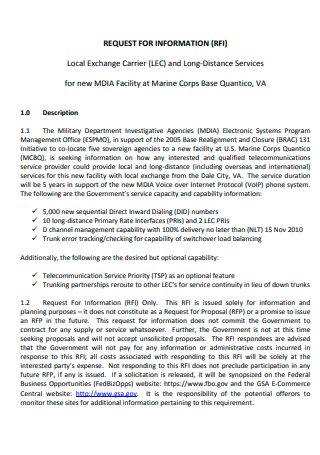
Request For Information Example
download now -

Notice of Request For Information
download now -
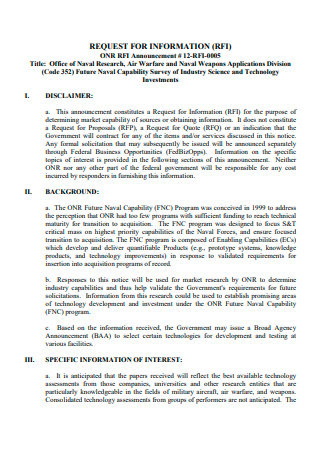
Standard Request For Information
download now -
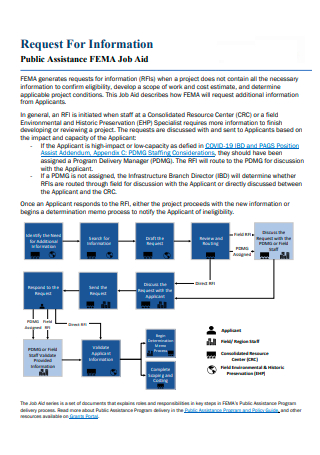
Request For Information in PDF
download now -
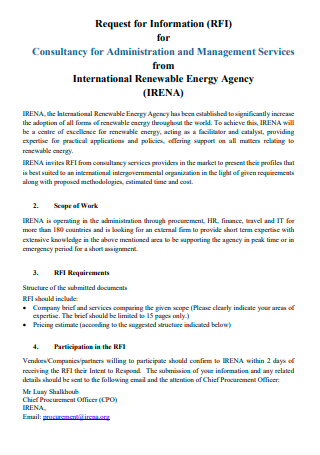
Request For Information For Consultancy Administration and Services
download now -
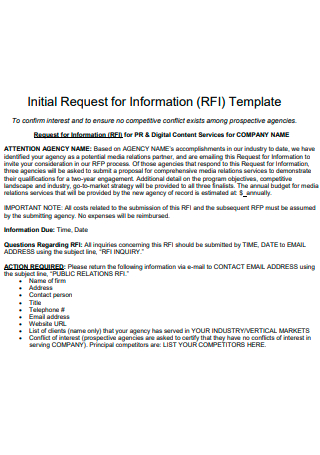
Initial Request For Information
download now -
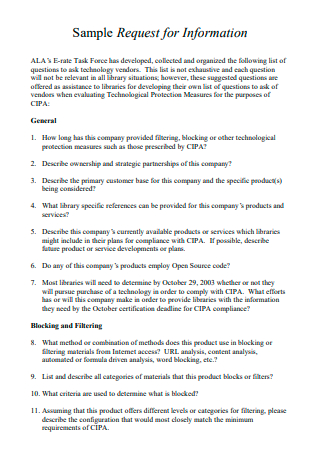
Sample Request For Information
download now -
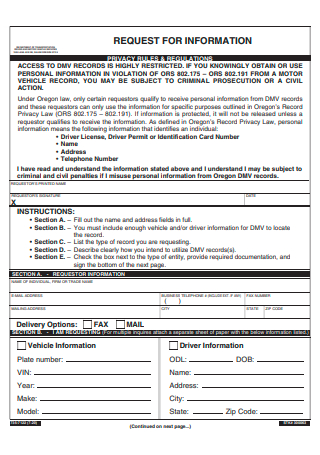
Formal Request For Information
download now -
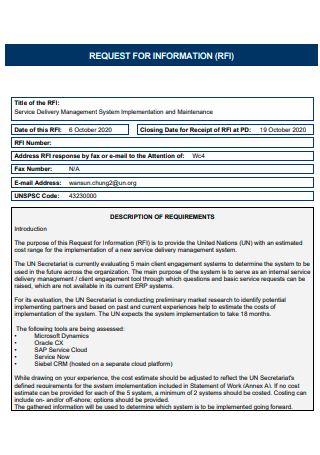
Printable Request For Information
download now -
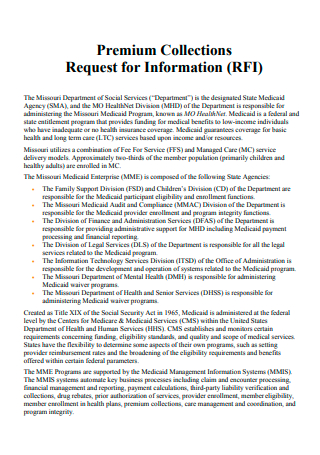
Premium Collections Request For Information
download now -
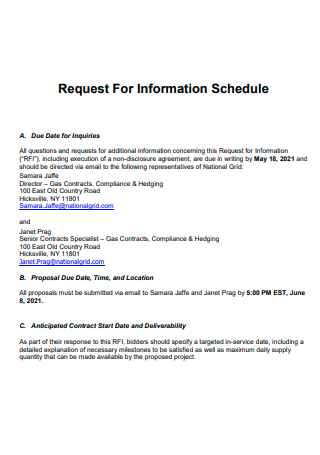
Request For Information Schedule
download now
FREE Request for Information s to Download
12+ SAMPLE Request For Information
What Is a Request for Information?
Why Are Requests for Information Important?
The Basic Elements of a Request for Information
How to Make a Request for Information
FAQs
What are the four main sections of RFI?
What is RFP?
What is RFQ?
What are the steps of the RFI process?
What makes a good RFI?
What Is a Request for Information?
A request for information or RFI is like an information sheet request written by customers or businesses and is sent to particular providers and suppliers. It is made for informational purposes to find out what vendors have to complete a project, compare responses from each vendor, save time in assessing each supplier candidate, and gather as much information on the market in a proper way. Thanks to RFIs, companies can directly state their needs and ask the right questions shortly.
According to Indeed.com, professionals request information to check company prices, confirm product and service officers, answer questions about certain needs, experience working on related projects, and set the timeline for establishing products and services.
Why Are Requests for Information Important?
Everyone has a right to be informed because it is basically how you start learning something. But rather than asking a question right away, why is there a need to write a document, form, letter, or email regarding a request for information? In this section, you will learn about why a request for information plays an important role.
Opportunity for Endless Information
A request for information gives you a chance to learn various information depending on what topic or concern you want to ask about. For example, Indeed taught us that there are five common reasons why professionals use requests for information—to confirm company prices, check product offers, answer the needed questions, experience working on similar projects, and set the timeline for products and services.
Accommodates Different Areas of Use
From construction, government, hospital, business, to any field of work, requests for information are useful for different purposes. For example, RFIs are crucial to obtain software from a specific vendor in the IT department. In construction, main contractors and subcontractors base on RFIs to answer certain questions. And you may also assess each competing advertising agency through RFIs. Hence, don’t simply limit RFIs to one area of use.
Respectful Way to Inform
To submit a request for information is a polite way to ask for details from certain vendors, clients, and companies. You don’t just bombard people with questions out of the blue since that is informal. So it is basically like writing a personal letter to your target and waiting for their response to give you the information you need. And if you need answers pronto, it works best to submit the request early.
Helpful for Research and Analysis
Once you acquire the infographics or informational data from your target, you don’t just get rid of RFIs that easily. You may need them for future purposes such as in researching for other potential partners and conducting data analysis from the RFI results. So the key is to put the RFIs and responses for safekeeping as you never know when your business needs to be open to working with other industries.
The Basic Elements of a Request for Information
While a request for information’s goal is clear, which is about requesting to inquire about something, how about what makes a request for information? Although there are slight differences in the layout, design, and format of most requests for information, you will also find common components if you look closely. And the standard elements of a request for information are:
How to Make a Request for Information
Writing a request for information should not be that difficult, especially when you already have enough background about the RFI’s definition, importance, and elements. So without further ado, these are the necessary steps for you to create an effective request for information:
Step 1: Recognize Your RFI Purpose
Why do you need to create RFIs in the first place? Get to know your purpose through analysis so that you would know what specific questions to ask in the request for information. The same goes for what not to include in the RFI or the elements that don’t align with your purpose. So if your company is more concerned about the pricing details, be sure the questions you ask are related to it so companies can respond easily.
Step 2: Follow a Sample Request for Information
Making requests for information has never been easier when you use sample templates in the process. Use a sample of request for information so you won’t have to start from scratch. Sample templates in PDF are already premade so you are guided with the standard layout, format, and content shortly. At the same time, you can edit the template so you don’t need to stick with the standard set of data. Sample RFI templates are customizable, printable, and downloadable anytime.
Step 3: Insert the Key Elements
RFI number, date, project name, project number, response deadline, statement of purpose, etc.—be sure to add the standard elements of a request for information into your document. These elements complete the RFI anyway. And besides these basic components, you may also insert more relevant elements into the RFI if you think they can improve your RFI and would still follow the purpose.
Step 4: Limit According to the Needed Information
Requesting information means you know your limits and boundaries according to what information you expect to receive. There is no need to ask for all sorts of information, especially when you already know what you want. Always focus on the purpose. So be specific with the needed information to request but don’t expect in-depth information as a response either. RFIs are meant for general information such as capability details and resource information.
Step 5: Be Polite
Just like writing any formal or business letter, being respectful with your tone and message is essential. Be cordial with your words because offending your recipients would mean you can only hope for a miracle to get a proper response from them. Reread your statements if you have not been too pushy, forceful, or impolite with your request. At the same time, don’t be too polite that you might mention you are okay with not getting a response from them. Just be genuine that you also need the response for your goal.
Step 6: Set a Fair Response Time
Most importantly, be realistic in setting a fair response time. Be punctual in writing the request for information because responses may be received longer than expected. Although you can mention the response deadline in the RFI, maybe recipients can’t respond right away if you expect an answer the very next day. Once you get the answers you need, thank them for responding and keep those results under safekeeping for future reference lists.
FAQs
What are the four main sections of RFI?
The four major sections of a request for information are the overview, information requested, response expectations, and clarification.
What is RFP?
RFP stands for request for proposal. And it is a document needed when you ask suppliers and vendors to provide a proposal that would solve your business needs, particularly on product or service proposals.
What is RFQ?
RFQ is an acronym for a request for quote or quotation. It is used to ask for the price or quote from suppliers about their products and services.
What are the steps of the RFI process?
An RFI process consists of three steps which are the creation, administration, and evaluation.
What makes a good RFI?
A good RFI is when you are able to insert the standard elements of an RFI and if the data inside consists of easily digestible information regarding providers and suppliers.
Compared to RFPs and RFQs, the request for information serves as the introductory statement of what basic information you want audiences to learn about your business or products and services. So be sure to take RFI writing seriously because it is responsible for getting the key answers and data needed for specific purposes. Thankfully, preparing RFIs won’t be a hassle anymore when you use sample request for information templates for reference. Download a sample now!
